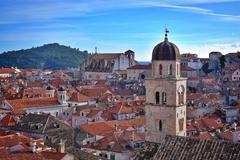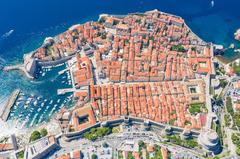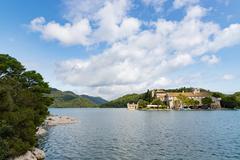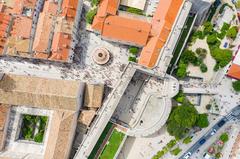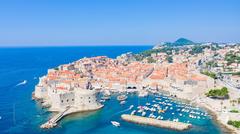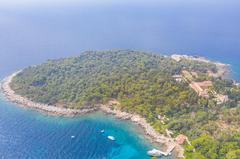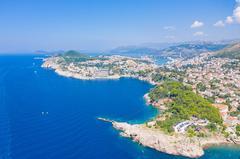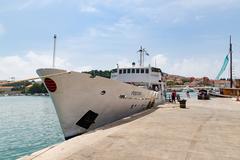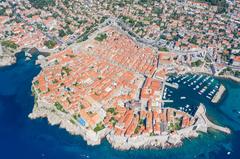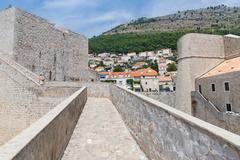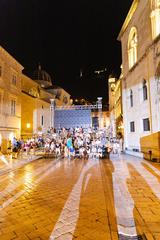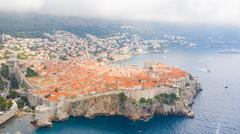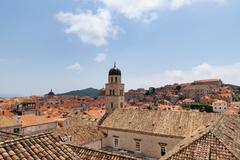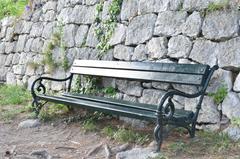
Comprehensive Guide to Visiting Dubrovnik-Neretva County, Croatia
Date: 13/08/2024
Captivating Introduction
Imagine stepping into a world where history breathes from every cobblestone street, and the azure waters of the Adriatic Sea beckon with a timeless allure. Welcome to Dubrovnik-Neretva County, Croatia’s southern gem, where the past and present intertwine in a mesmerizing dance. This county, with Dubrovnik as its crowning jewel, has a story that rivals the most gripping epic tales. From the grandeur of the Republic of Ragusa, which once ruled the waves with keen diplomacy, to the resilience shown during the Croatian War of Independence, Dubrovnik-Neretva County is a tapestry woven with threads of history, culture, and breathtaking beauty (CroatiaTraveller).
As you wander through the narrow streets of Dubrovnik’s Old Town, it’s almost as if the medieval walls whisper the secrets of centuries past. These fortifications, some of the most complete in Europe, stand as proud sentinels of the city’s storied past. It’s no wonder Dubrovnik has been a UNESCO World Heritage Site since 1979, offering visitors not just a glimpse but an immersive dive into a bygone era (TravelMagazine). Whether you’re drawn by the strategic intrigues of the Ottoman Empire or the transformative impacts of the Napoleonic Wars, Dubrovnik-Neretva County promises an adventure that transcends time.
But history is just the beginning. Picture yourself indulging in local delicacies, exploring hidden gems like the historic town of Ston, or simply soaking in the sun on the pristine beaches. This guide will not only take you through the historical marvels but also share insider tips, hidden treasures, and practical advice to make your visit unforgettable. So grab your walking shoes, your curiosity, and perhaps a hearty appetite for both knowledge and cuisine, as we embark on a journey to discover the secrets of Dubrovnik-Neretva County.
Table of Contents
Historical Background of Dubrovnik-Neretva County
Discover the Enigmatic Past of Dubrovnik-Neretva County
Dubrovnik-Neretva County, located at the southern tip of Croatia, has a rich and storied history. Imagine a time when the Republic of Ragusa, with Dubrovnik as its dazzling capital, ruled the waves. From the 14th century until 1808, this maritime republic thrived on its wealth and shrewd diplomacy, cleverly navigating alliances with powerful neighbors like the Ottoman Empire and the Republic of Venice. Picture the bustling trade and vibrant culture that made Dubrovnik, known as Ragusa in Latin, a shining beacon of the medieval world (CroatiaTraveller).
Medieval Marvels and UNESCO Glory
Step into the old city of Dubrovnik, and you’ll feel like you’ve been transported back in time. With its incredibly well-preserved architecture, it’s no wonder the city has been a UNESCO World Heritage Site since 1979. The iconic city walls, built between the 12th and 17th centuries, stretch about 2 kilometers and offer breathtaking views of the Adriatic Sea. These fortifications are among the most complete in Europe, standing as a testament to Dubrovnik’s medieval might (TravelMagazine).
Ottoman Empire Intrigues
Despite its prosperity, Dubrovnik-Neretva County has always been somewhat of an enigma, partly due to its geographical isolation. During the height of the Ottoman Empire, Dubrovnik maintained its independence by paying tribute to the Ottomans, a savvy move that allowed it to flourish while other regions were caught in conflict (CroatiaTraveller).
Napoleonic Drama and Austrian Rule
The fall of the Ragusan Republic came with the Napoleonic Wars. In 1806, French troops marched into Dubrovnik, and by 1808, Napoleon had officially abolished the Republic. After Napoleon’s fall, the Congress of Vienna in 1815 placed Dubrovnik under Austrian rule, where it stayed until the end of World War I. This period brought modernization and new administrative practices, transforming the city into a modern hub (TravelMagazine).
20th Century Twists and Turns
The 20th century saw Dubrovnik-Neretva County undergo even more changes. After World War I, the region became part of the Kingdom of Serbs, Croats, and Slovenes, later known as Yugoslavia. During World War II, Dubrovnik faced occupation by Italian and then German forces. After the war, it was part of the Socialist Federal Republic of Yugoslavia, a time marked by development, political repression, and economic challenges (TravelMagazine).
Croatian War of Independence
One of the most significant recent historical events was the Croatian War of Independence (1991-1995). Dubrovnik was besieged by the Yugoslav People’s Army (JNA) in 1991, causing substantial damage to the city’s historic center. The seven-month siege saw heavy shelling, but the international community condemned the attack, and extensive restoration efforts have since returned Dubrovnik to its former splendor (TravelMagazine).
Preservation and Modern-Day Charm
Today, Dubrovnik-Neretva County is a vibrant region that seamlessly blends its rich historical heritage with modern tourism. The preservation of its historical sites, like the city walls, forts, and churches, is a testament to the region’s dedication to maintaining its cultural legacy. This historical significance is not just a point of pride for locals but also a magnet for tourists from around the globe (GoDubrovnik).
Insider Tips for a Historical Adventure
Want to dive into the history of Dubrovnik-Neretva County? Here are some insider tips to enhance your experience:
- City Walls Tour: Walking the city walls of Dubrovnik is a must. The 2-kilometer loop offers stunning views and a unique perspective on the city’s medieval architecture. Pro tip: Buy your tickets online to skip the long queues (GoDubrovnik).
- Museums: The Red History Museum offers a fascinating look into the region’s more recent past, including the Yugoslav era and the Croatian War of Independence. Grab a Dubrovnik Card for access to multiple museums and historical sites—it’s a dream come true for history buffs (TravelMagazine).
- Local Guides: For a deeper dive into the county’s history, hire a local guide. Many, like the charming Ivan Vukovic, offer personalized tours that cover both well-known landmarks and hidden gems (TravelMagazine).
- Seasonal Visits: Visiting during the off-season, such as March-April or October, can provide a more relaxed experience with fewer crowds. Plus, it’s a fantastic time to interact with locals and partake in traditional events like the Dubrovnik Winter Festival (TravelMagazine).
Conclusion
Dubrovnik-Neretva County’s historical background is a tapestry of maritime prowess, strategic diplomacy, and resilience through conflict. From the days of the Ragusan Republic to the modern era, the region’s history is preserved in its architecture, museums, and cultural practices, offering visitors a rich and immersive experience.
Visitor Tips for Dubrovnik-Neretva County, Croatia
Welcome to the Enchanting Dubrovnik-Neretva County
Imagine strolling through ancient streets where history whispers from every corner, or diving into crystal-clear waters under the warm Mediterranean sun. Welcome to Dubrovnik-Neretva County, a place where every moment feels like a scene from a mesmerizing tale.
Best Time to Visit
Dubrovnik-Neretva is a dream from April to early October. While the summer months of July and August bring a bustling vibe, the shoulder seasons of late spring (April to June) and early autumn (September to October) offer serene beauty with fewer crowds. Picture yourself meandering through historic streets with the perfect balance of sunshine and tranquility (Active Traveller).
Getting There and Around
Fly into Dubrovnik Airport, your gateway to this magical county. From there, hop on a shuttle bus, hail a taxi, or rent a car to start your adventure. Ferries and catamarans are your sea-bound chariots, linking Dubrovnik with stunning islands and coastal gems. For local jaunts, public buses, taxis, or Uber are your best friends, while walking lets you soak in the charm of historic towns like Dubrovnik and Korčula (Audiala).
Currency and Payments
As of January 2023, Croatia has embraced the Euro (€). Carry some Euros for small buys, but don’t fret—credit and debit cards are widely accepted. ATMs are plentiful in urban areas and tourist hubs (The Travel Pockets).
Health and Safety
- Hydration: Keep a water bottle handy. Refill at the many water fountains in Dubrovnik’s Old Town.
- Sun Protection: Be sun-savvy! Sunscreen, hats, and sunglasses are a must under the intense Adriatic sun.
- Swimming: Always wear your swimsuit. The inviting Adriatic waters are perfect for a spontaneous dip (The Travel Pockets).
Exploring Old Town Dubrovnik
Rise with the sun to explore Dubrovnik’s Old Town. Beat the crowds and bask in the beauty of ancient architecture and narrow streets. Walking the city walls is a must—expect jaw-dropping views of the city and the shimmering Adriatic Sea (Active Traveller).
Dining and Cuisine
Foodies, rejoice! Dubrovnik-Neretva County serves up a feast of flavors—from hearty meat dishes to fresh seafood and delectable pastries. For budget-friendly bites, venture outside Old Town Dubrovnik’s walls. Savor local specialties like black risotto, octopus salad, and Dubrovnik’s renowned pastries (Active Traveller).
Accommodation
From luxury hotels and boutique guesthouses to budget hostels and private apartments, there’s a perfect spot for every traveler. Book ahead, especially during peak season. For a quieter stay, consider Lapad or Gruž, just a stone’s throw from the Old Town charm (Audiala).
Transportation Tips
- Walking: The narrow, pedestrian-friendly streets of Dubrovnik’s Old Town are best explored on foot.
- Public Transport: Efficient buses cover most tourist areas. Grab a daily or weekly pass for cost-effective travel.
- Driving: Narrow streets and limited parking make driving a challenge. Opt for public transport or taxis within the city (The Travel Pockets).
Outdoor Activities
Nature lovers, Dubrovnik-Neretva County is your playground. Explore Mljet National Park’s lush forests and saltwater lakes or dive into the pristine waters of the Lastovo archipelago. These protected areas promise unspoiled beauty (Audiala).
Cultural Insights
Feel the ancient stones under your feet, hear the waves crash, smell the sea breeze, taste local delicacies, and see vibrant market colors. Dubrovnik-Neretva County is a sensory delight. Embark on a scavenger hunt through Dubrovnik’s Old Town or quest for the county’s best pastry (Audiala).
Seasonal Highlights
Each season paints Dubrovnik-Neretva County with unique charm. Summer is for festivals and lively streets, while winter offers peaceful exploration. Discover the county’s magic year-round (Audiala).
Hidden Gems
Step off the beaten path to discover Medieval Cavtat, historic Ston, and charming Korčula. These hidden treasures offer rich history and picturesque settings away from the tourist crowds (Active Traveller).
Final Tips
- Download the Audiala App: Enhance your travel with Audiala, your ultimate guide to Dubrovnik-Neretva County.
- Plan Ahead: Reserve popular attractions and restaurants in advance, especially during peak season.
- Stay Informed: Keep up with local news and weather to ensure smooth travel plans (Audiala).
By following these tips, you’re set for an unforgettable adventure in Dubrovnik-Neretva County. Embrace the journey and let the magic unfold.
Call to Action
As our journey through Dubrovnik-Neretva County draws to a close, it’s clear why this region holds a special place in the hearts of travelers and historians alike. From its inception as the illustrious Republic of Ragusa to its resilience in the face of modern conflicts, this county has continuously reinvented itself while preserving its rich heritage. The architectural splendors of Dubrovnik’s Old Town, the strategic fortifications, and the vibrant local culture create a mosaic of experiences that cater to history buffs, adventure seekers, and culinary enthusiasts alike (GoDubrovnik).
Whether you’re walking the ancient city walls, savoring a plate of black risotto, or exploring the natural beauty of Mljet National Park, Dubrovnik-Neretva County offers an endless array of sensory delights. The county transforms with the seasons, offering unique experiences year-round, from bustling summer festivals to the serene charm of a winter visit. This guide has aimed to provide not just a historical overview but practical tips and hidden gems that will make your visit truly special.
Don’t just take our word for it; let Audiala, your ultimate travel companion, guide you through this enchanting region. With beautifully crafted audio guides, expert insights, and exclusive access to hidden treasures, Audiala ensures that your journey is as rich and immersive as possible. Download Audiala before your visit to unlock the secrets and stories of Dubrovnik-Neretva County and make your adventure truly unforgettable.
References
- CroatiaTraveller. Discover the Enigmatic Past of Dubrovnik-Neretva County. (source url).
- TravelMagazine. Dubrovnik, Croatia: Everything You’ll Want to Know Before You Visit. (source url).
- GoDubrovnik. Things to Do in Dubrovnik. (source url).
- Active Traveller. Dubrovnik and Neretva County: History, Culture, and Must-See Sights. (source url).
- Audiala. Your Ultimate Guide to Dubrovnik. (source url).
- The Travel Pockets. How to Spend 36 Hours in Dubrovnik, Croatia in August. (source url).
